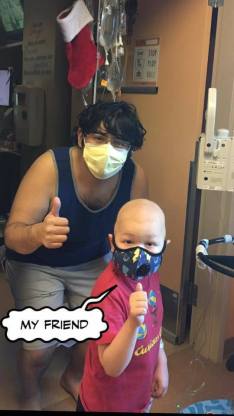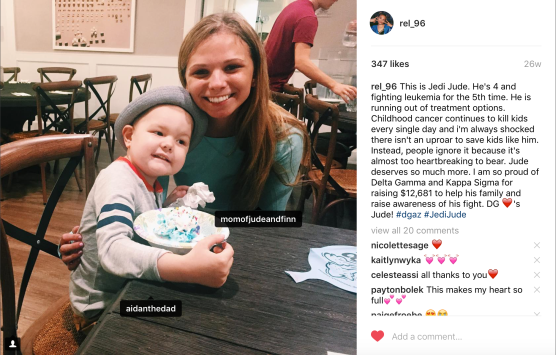
According St. Baldrick’s and the National Cancer Institute, every year in the USA 13,400 children under age 19 are diagnosed with cancer. That is 36 children diagnosed with cancer a day, enough to fill an entire classroom.
Every day, 7 children lose their life to cancer, making cancer the largest cause of death by disease in children under 19. This is more than AIDS’s, asthma, diabetes, cystic fibrosis and congenital abnormalities combined. The treatments the
se children endure also give them lifelong side effects.
Because of the treatments they endured to save their lives, by the time these children enter their 30s or 40s, nearly ⅔ of the children will have chronic or life-threatening diseases. Despite these staggering statistics, childhood cancer remains grossly underfunded and there is a significant lack of research.


The National Cancer Institute reports that childhood cancers make up only 1% of all cancer diagnoses. Because of how rare it is, many people believe that the research needs to go to the people who will get the most benefit out of the research. However, this is denying the littlest cancer victims a fair chance at life. On average, an adult diagnosed with breast cancer at the average age of 61 looses 16 years of life. A child diagnosed with cancer loses an average of 67 years of life. This means that even though fewer children get cancer, those who do pay a larger price in lost years of life. However, the problem is much bigger than this. The problem lies within the organizations we trust to find a cure for cancer.
The problem t

hat only a small percentage of the hard earned money that people are raising is being used for the purpose of research and finding a cure. According to James Bennett, professor of economics at George Mason University, the American Cancer Society held a fund balance of over 400 million dollars with about 69 million dollars in holdings of land, buildings and equipment. Of that money, the ACS spent only $90 million— 26 percent of its budget— on medical research and programs.
The rest of this money covered “operating expenses”. These operating expenses gave 60 percent in generous salaries, executive benefit s, and pensions. So for every dollar spent on direct services, approximately $6.40 is spent on compensation and overhead. This leaves 16 percent or less on direct services for cancer victims.There is no lack of money. There is no lack of fundraising. However we are fundraising for a billion dollar industry that cares little about its mission and pays large corporate salaries.
s, and pensions. So for every dollar spent on direct services, approximately $6.40 is spent on compensation and overhead. This leaves 16 percent or less on direct services for cancer victims.There is no lack of money. There is no lack of fundraising. However we are fundraising for a billion dollar industry that cares little about its mission and pays large corporate salaries.
Research for childhood cancer should get its fair share of funds, however, with such little money spent on research and programs for people fighting cancer, how can each cancer get the research it deserves? The answer is, it can’t. Someone is going to get the short end of the stick, and those victims are the children. Why? Because childhood cancers are not profitable to pharmaceutical companies and private industries.
One of the families that has been forced to fundraise in order to save their son’s life, is Barbara and Aidan Anderson from Tucson, Arizona. Their 4 year old son, Jude, is fighting Acute Lymphoblastic Leukemia for the 4th time. After surviving 2 bone marrow transplants, Jude is now doing well and looking forward to starting Kindergarten in September! We recently discussed with his mom the underfunding of pediatric cancer in the below interview.
You can see more of Jude’s story in the following video:
The funding and research for children has gone down every year since 2003. In 2008, the funding was 26.4 million. In comparison, the NCI set aside $254 million for AIDS research, and funding for breast cancer topped $584 million the same year. In 2011, the National Cancer Institute’s budget was 5.196 billion dollars. Of that budget, childhood cancer received the least amount of money, only 3.7%. However, both of these organizations use children with cancer as a huge marketing tool. By posting a bald child on their marketing collateral, the general public feels morally obligated to help save a child’s life. Little do they know where the money is actually going, and who is reaping all of the benefits.

Common misconceptions also frequently lead to a lack of research. Most people believe that childhood cancer is the same thing as cancer in an adult, just miniature. Because of this, there does not need to be research specifically designated to childhood cancers. We can just take the adult drugs and modify the dosage to help children.
The truth however, is that pediatric cancers are vastly different from adult cancers. Prostate, breast, colon and lung cancer do not occur in children. The most common childhood cancers are leukemia’s, brain tumors, kidney tumors and solid tumors throughout the body. Of each type of cancer, there are hundreds of different subtypes, each having its own treatment and prognosis. For example, there are hundreds of different childhood brain tumors that won’t be seen in adults. Astrocytoma, atypicical teratoid Rabdoid tumor, gangilogioma, medulloblastoma, oligodendroglioma, craniopharyngioma are all brain tumors exclusively in children. These tumors and cancers need to be treated differently. However, despite this there has only been one new childhood cancer drug developed in the last 20 years.

Out of all of the chemotherapy drugs on the market, only 4 drugs are approved by the FDA for use on children. In contrast, there are about 200 adult chemotherapeutic agents. Also, the chemotherapies and radiation commonly used to treat children children are toxic. Radiation given to children’s developing brain can significantly lower IQ, as well as limit the ability to read, do basic math, tell time, or even talk. So children are surviving, but at a very high cost. Many children develop secondary cancers and many other lifelong problems due to chemotherapies given to them as children to save their lives. Because of the treatments, by the time these children enter their 30s or 40s, more than 73% of survivors will have a chronic health problem such as vision impairment, hearing impairment, infertility, or secondary cancers.
This is an unacceptable situation. Childhood cancer continues to kill children every single day and people turn a blind eye to it because it is almost to heartbreaking to bear. Children are our most valuable asset, they are our future.
https://www.instagram.com/p/BK2D3M1DAiCiScRwsYxC-R_R91PxXbU5RORVt40/?taken-by=rel_96&hl=en
https://www.instagram.com/p/BK2D3M1DAiCiScRwsYxC-R_R91PxXbU5RORVt40/?taken-by=rel_96&hl=en

https://www.instagram.com/p/BK2D3M1DAiCiScRwsYxC-R_R91PxXbU5RORVt40/?taken-by=rel_96&hl=en
https://www.instagram.com/p/BK2D3M1DAiCiScRwsYxC-R_R91PxXbU5RORVt40/?taken-by=rel_96&hl=en
